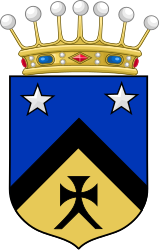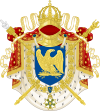Faesch
| Fesch | ||
|---|---|---|
Style(s) Serene Highness | | |
| Estate(s) | France | |
The Faesch family, also spelled Fesch, is a prominent
In the 18th century, the naval officer Franz Fesch (1711–1775) entered the service of the
Family members have lived in Switzerland, Corsica, Italy, France and Belgium. Many family members have been notable as jurists, bankers or military officers.
History

The family is said to be of ancient nobility from Valais in Switzerland.[1] Two brothers of the family acquired the hereditary burghership of Basel in 1409. Family members became members of the council, and thus the ruling class of the city-republic of Basel, from 1494. Members of the family served continuously in the government of the city from the mid 16th century until the end of the 18th century. Several family members also became Burgomaster's and thus heads of the republic, and others became Rectors of the University of Basel. The family intermarried for centuries with other prominent patrician families. Remigius Faesch (ca. 1460–1533) was a famous architect.






The goldsmith and member of the city council Hans Rudolf Faesch (1510–1564) was ennobled by Ferdinand I, Holy Roman Emperor in 1563 and received a confirmation of the family arms that added two stars to their crest. Thus the family held a dual status as patricians or members of the Daig of the burgher republic of Basel, and as nobles of the Holy Roman Empire.
As of 1659, the Faesch family was the richest family of Basel with a fortune of nearly 250,000 florins. Their family foundation still exists. The jurist, rector of the University of Basel and art collector Remigius Faesch (1595–1667) founded Museum Faesch, an art museum. Its collection became part of the University of Basel in 1823.
Several family members entered the service of various European princes. The diplomat Johann Rudolph Faesch (1669–1751) was an adviser to the
The family converted to
A branch of the family settled in Geneva in the 19th century, where Alphonse François Faesch became a judge. His son, the engineer Jules Faesch, became a co-owner of the Faesch and Piccard company, and married Amélie de Senarclens de Vuflens (1842-1910), who inherited Vufflens Castle from her father.
The family name Faesch or Fesch means roughly "
Fesch as part of the imperial family of France
Franz Faesch (born 1711 in
Notable family members
- Caroline Weldon, née Faesch (1844–1921), American civil rights activist, Indian rights activist of the late 19th century,[2]
- Remigius Faesch (builder) (about 1460–1533/1534), builder of the late Gothic era
- Christoph Faesch (1611–1683), historian
- John Jacob Faesch (1729-1799), black smith and iron master, patriot of the American Revolution
- Johannes Faesch (1779–1856), merchant
- Jules Faesch (1833–1895), engineer
- Emil Faesch (1865–1915), architect
- Isaac Faesch (1687–1758), merchant and governor of the Dutch Antilles 1740–1758[3]
The Fesch Palace in Ajaccio as of 2014[update] houses the Musée Fesch.
Coat of arms
-
Coat of arms of Johann Jakob Faesch, rector of the University of Basel, 1612
-
Faesch family coat of arms
-
Faesch family coat of arms with a baronial coronet as used by family members, as the family was ennobled by the Holy Roman Emperor in 1563. The two stars were added on the occasion of the ennoblement.
-
Arms of Cardinal Joseph Fesch as a member of the French imperial family, Grand Almoner of France and a prince of the Empire
References
- ^ Zeitung für den deutschen Adel, Vol. 1, p. 414, Helbig, 1840
- ^ Caroline Weldon, née Faesch genealogy http://worldconnect.rootsweb.ancestry.com/cgi-bin/igm.cgi?op=GET&db=caroline_weldon&id=I03
- ISBN 978-90-04-27132-6. Seiten 40f
Literature
- Friedrich Wilhelm Bautz (1990). "Faesch". In Bautz, Friedrich Wilhelm (ed.). Biographisch-Bibliographisches Kirchenlexikon (BBKL) (in German). Vol. 2. Hamm: Bautz. cols. 22–23. ISBN 3-88309-032-8.
- Jean Baptiste Lyonnet: Le Cardinal Fesch, archevêque de Lyon, primat des Gaules, etc., etc. Fragments biographiques, politiques et religieux pour servir à l'histoire ecclésiastique contemporaine. 2 Bde., Lyon-Paris, Perisse, 1841.
- Samuel Schüpbach-Guggenbühl: Faesch in German, French and Italian in the online Historical Dictionary of Switzerland.





